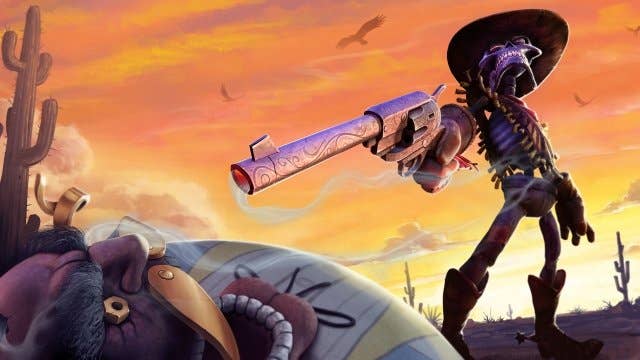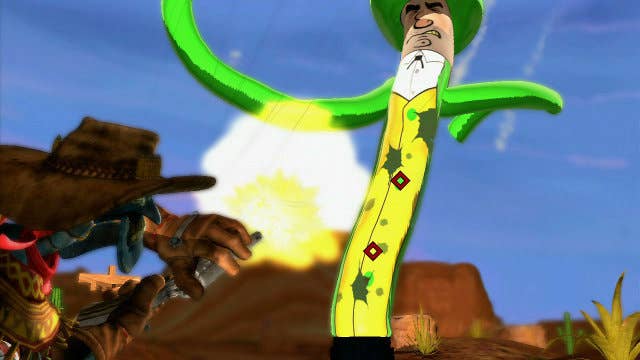Critical Consensus: The Gunstringer
Does Twisted Pixel's latest offer core Kinect owners a reason to be cheerful?
The question of whether Kinect games can find success with core gamers hasn't yet been answered satisfactorily. Q-Games' brief, barmy Child Of Eden certainly offered a unique experience, but with lifetime sales barely scraping 130,000 units Ubisoft will be in no rush to commission a sequel.
This is the moment that The Gunstringer is supposed to ride into town and rescue the Kinect from the same dusty corner that core gamers currently keep their Wii. After all, this is the latest from Twisted Pixel, the indie darlings behind 'Splosion Man and Comic Jumper; they of the quick wit and the silly songs, the saviours of FMV. Microsoft was so impressed by its work on Gunstringer that the project was promoted from XBLA release to full-priced box product.
This couldn't just be Microsoft trying to offer something - anything - to allay core gamers' fears that Kinect was just a fancy remote control, could it? Could it? It would take a hard-hearted cynic to think so, and the critical community has welcomed The Gunstringer with unanimous praise - well, almost.
The odd one out is Edge magazine, which is less than impressed with The Gunstringer's marionette puppet gameplay conceit.
That The Gunstringer is a marionette isn't just for quirkiness' sake...the controls are elegant, intuitive, and responsive
Ryan Davis
"Like Child of Eden, players 'paint' their targets with a reticule before firing (though, to shoot, The Gunstringer opts for a slightly clearer arm-raising motion that mimes the kickback from firing a gun). There's no provision for precise aiming, and switching weapons is only possible at predefined points - though Twisted Pixel does a valiant job of wringing out what variety it can."
The game's "puppet protagonist" also proved unresponsive, reducing the game's handful of melee sequences to an exercise in flailing limbs. Kinect also displays the frustrating tendency to misinterpret player gestures, giving the protagonist a curious penchant for sticking his head out of cover when he's told to duck.
The Gunstringer's biggest problem, however, is that it's a score-based shooter with little incentive to return. With only one weapon type available at any given time, there's none of the tactical interplay between attacks that makes aiming for high scores in Child Of Eden so tempting."
The final score is 5 out of 10, but that's largely out-of-step with the critical majority. Games Radar's Lorenzo Veloria, for example, offered a more charitable 7 out of 10, despite voicing many of the same criticisms. The Gunstringer's trump card, it seems, is its presentation: the game plays out on a puppet show stage, complete with live audience cheering and jeering your every move.
"The levels are constructed out of painted cardboard, stitched fabrics, and are even manipulated by the giant live-action hands of the puppeteers and stagehands. The stagehands will roll boulders, break bridges, and place explosives all in the interest of making the 'show' more entertaining for the audience."

"Twisted Pixel did an excellent job creating a unique backdrop that adds to the comical tone of the game's story and gives gamers something they haven't seen before."
Giantbomb's Ryan Davis offers similarly fulsome praise for Twisted Pixel's canny aesthetic sense in his 4 star review, but, calibration issues with Kinect notwithstanding, The Gunstringer also delivers in terms of gameplay.
"That The Gunstringer is a marionette isn't just for quirkiness' sake. It's a concept that extends to the game's fundamental controls, which provide a little lateral movement, plus the ability to hop over certain obstacles, to what is essentially an on-rails shooter. Using your left hand to guide his movements, and your right to guide a targeting reticule that lets you paint up to six targets before kicking back in mock-recoil to trigger the shots, the controls are elegant, intuitive, and responsive."
The Gunstringer is brief - a possible relic from its days as an XBLA game scheduled to retail at less than half its current price - but Davies commends Microsoft and Twisted Pixel for loading the package with as many extras a gamer could reasonably want: mods that change gameplay and presentation, commentary tracks with the dev team and Xbox types, a crop of excellent behind-the-scenes videos, and a download code for Fruit Ninja Kinect.
But the jewel in the crown for Davis is so special it made Joystiq's Justin McIlroy temporarily lose control of his critical sensibilities.

"There's a component of The Gunstringer that's so wonderful, so specifically hand-crafted just for me that my continued happiness relies on more of it being made," he wrote in his 5 star appraisal of the game. "This is my review of the The Gunstringer, and I cannot be trusted."
The object of McIlroy's affection is "The Wavy Tube Man Chronicles" - a 40-minute tribute to that hoary FMV classic Mad Dog McCree, featuring mid-Nineties indie actor Wiley Wiggins and Troma Films magnate Lloyd Kaufman on the hunt for the latter's stolen time machine.
"If my heart were a closet, and you started digging around to find the items that seemed most worn, most loved, the outfit you would emerge with would be 'The Wavy Tube Man Chronicles'," he gushes.
"How do I live in a world where something this heart-stoppingly incredible exists? And not only exists, but is free day-one DLC for an already hugely enjoyable game?"
"The Gunstringer has some problems. Its sitting controls aren't perfect. It needs some tonal variation. The movement controls take some getting used to. If you're asking me if you should play it though, I have a single, one word answer. Hint: It starts with 'Y'."








